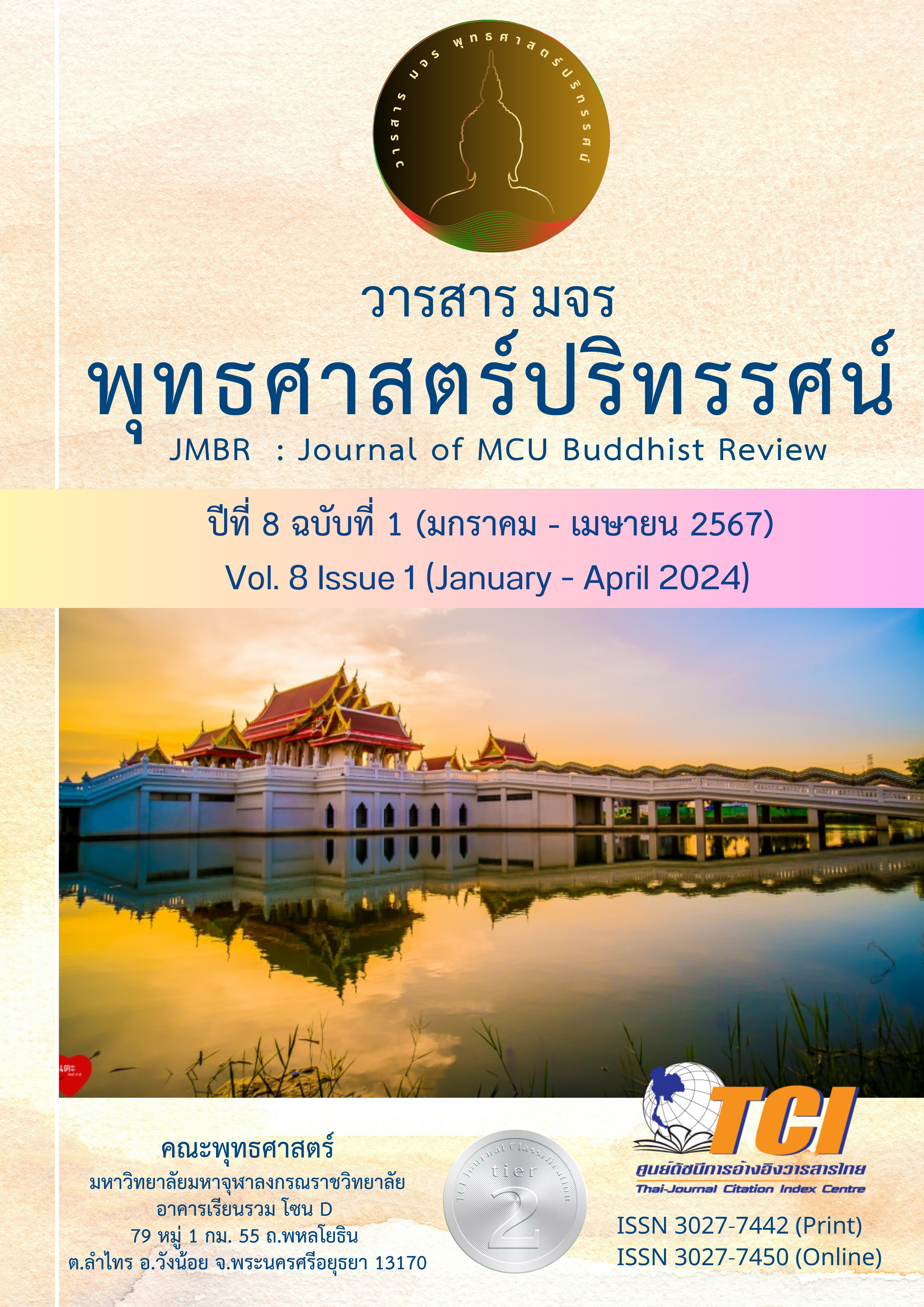ผลของการฝึกเจริญสติกราบพระด้วยธรรมคีตะ
Main Article Content
บทคัดย่อ
บทความวิจัยนี้มีวัตถุประสงค์ 1) เพื่อศึกษาปัญหาของการฝึกเจริญสติด้วยตนเองที่บ้านที่ทำงาน 2) เพื่อศึกษาและสร้างกระบวนการพัฒนาการฝึกเจริญสติสำหรับคนทำงาน 3) เพื่อประเมินและนำเสนอผลของการฝึกเจริญสติกราบพระด้วยธรรมคีตะ เป็นงานวิจัยเชิงคุณภาพ พื้นที่กลุ่มตัวอย่าง ผู้ให้ข้อมูลสำคัญจำนวน 20 คน เครื่องมือที่ใช้ในการเก็บข้อมูลคือการสัมภาษณ์เชิงลึกและการประชุมกลุ่มย่อย วิเคราะห์ข้อมูลโดยใช้การวิเคราะห์แก่นสาระ จากข้อมูลการใช้แบบสัมภาษณ์เชิงลึก เขียนบรรยาย นำเสนอเชิงพรรณนา ผลการวิจัยพบว่า 1) ปัญหาอุปสรรคในการปฏิบัติธรรมเจริญสติด้วยตนเองที่บ้านที่ทำงาน มีอยู่ 3 ปัญหาใหญ่ๆ คือ ปัญหาในการเจริญสติในการทำงานเนื่องจากงานและผัสสะระหว่างการทำงาน ปัญหาที่สองเป็นปัญหาในการเจริญสติในเรื่องของการจัดการเวลาในการปฏิบัติธรรมเข้ามาในชีวิตการทำงาน และปัญหาที่สามเป็นปัญหาในการเจริญสติในเรื่องสภาพอินทรีย์ 5 คือ ศรัทธา วิริยะ สติ สมาธิ ปัญญา มีกําลังอ่อน 2) เปิดเพลงธรรมคีตะเพลงขอขมากรรมและเพลงองค์ใดพระสัมพุทธ น้อมจิตไปตามบทเพลงและเจริญสติกราบพระช้าๆรู้กายใจ รู้สภาวะธรรมที่เกิดขึ้น ผู้ปฏิบัติจะต้องฝึกอย่างน้อยวันละ 2 ครั้ง ก่อนการทำงานและก่อนนอนต่อเนื่องเป็นเวลา 14 วัน หรือ 2 สัปดาห์ 3) ผลของการฝึกเจริญสติกราบพระด้วยธรรมคีตะ คือส่งผลต่อสติ จิตใจและการทำงาน ข้อเสนอแนะในการนำผลวิจัยไปใช้คือการจัดสัมมนาให้ความรู้เกี่ยวกับผลของการฝึกเจริญสติกราบพระด้วยธรรมคีตะให้แก่พนักงานและการจัดฝึกอบรบแก่พนักงานในองค์กรให้ได้มีการฝึกเจริญสติกราบพระด้วยธรรมคีตะ องค์ความรู้ที่ได้รับ สามารถนำไปเผยแพร่ให้พนักงานในองค์กรที่มีปัญหาในการฝึกเจริญสติด้วยตนเองที่บ้านที่ทำงาน ไปลองฝึกปฏิบัติได้ อย่างไรก็ตาม ก่อนจะนำไปฝึกปฏิบัติเองที่บ้านควรได้เข้าฝึกอบรมและได้รับการนำปฏิบัติจากวิทยากรก่อนเพื่อส่งผลต่อประสิทธิผลของการปฏิบัติ
Article Details

อนุญาตภายใต้เงื่อนไข Creative Commons Attribution-NonCommercial-NoDerivatives 4.0 International License.
- บทความที่ได้รับการตีพิมพ์เป็นลิขสิทธิ์ของวารสาร มจร พุทธศาสตร์ปริทรรศน์
- ข้อความใดๆ ที่ปรากฎในบทความที่ได้รับการตีพิมพ์ในวารสาร ถือเป็นความรับผิดชอบของผู้เขียนบทความ และข้อคิดเห็นนั้นไม่ถือว่าเป็นทัศนะและความรับผิดชอบของกองบรรณาธิการวารสาร มจร พุทธศาสตร์ปริทรรศน์
เอกสารอ้างอิง
เกวลี แสดงฤทธิ์. (2565). ประสิทธิผลของเสียงดนตรีเพื่อการบำบัดที่มีผลในการลดภาวะหมดไฟในการทำงานและเพิ่มคุณภาพการนอนหลับของบุคลากรโรงพยาบาลเอกชนในเครือแห่งหนึ่งในจังหวัดระยอง. วิทยานิพนธ์ปรัชญาดุษฎีบัณฑิต คณะสาธารณสุขศาสตร์: มหาวิทยาลัยบูรพา.
จิดาภา เกิดสุริวงษ์ และคณะ. (2565). ผลของโปรแกรมดนตรีพุทธบำบัดต่อการเพิ่มสมาธิต่อเนื่องสำหรับนักเรียน ที่มีความต้องการพิเศษระดับมัธยมศึกษาตอนต้น โรงเรียนพิบูลประชาสรรค์ กรุงเทพฯ, วารสาร มจร มนุษยศาสตร์ปริทรรศน์. 8(2), 37-63.
นันทวัน มะยะเฉี่ยว. (2552). ผลของการฟังเพลงธรรมะต่อคุณภาพการนอนหลับของผู้ป่วยสูงอายุในโรงพยาบาล มหาวิทยาลัยสงขลานครินทร์. วิทยานิพนธ์พยาบาลศาสตรมหาบัณฑิต สาขาการพยาบาลผู้ใหญ่: มหาวิทยาลัยสงขลานครินทร์.
เบญจ์ ปูองกันภัย. (2562). ผลฉับพลันของการฟังดนตรีคลาสสิกที่มีต่อความเครียดในคนวัยทำงาน. วิทยานิพนธ์วิทยาศาสตร์มหาบัณฑิต คณะวิทยาศาสตร์การกีฬา: จุฬาลงกรณ์มหาวิทยาลัย.
ปองหทัย จันทร์มณี และ สุนิสา ไทยจินดา. (14 มีนาคม 2565). ผลของการฟังดนตรีผ่อนคลายเพื่อลดภาวะความเครียดในวัยทำงาน. สืบค้น 8 มีนาคม 2567 จาก https://postgrads.mfu.ac.th/wp-content/uploads/2022/12/6252003270.pdf
พระพรหมคุณาภรณ์ (ป.อ.ปยุตฺโต). (2546). พจนานุกรมพุทธศาสตร์ ฉบับประมวลธรรม. สืบค้น 8 มีนาคม 2567 จาก https://84000.org/tipitaka/dic/d_item.php?i=225
พระไตรปิฎก ฉบับหลวง เนื่องในโอกาสสมโภชกรุงรัตนโกสินทร์ 200 ปี. (2525). กรุงเทพฯ: โรงพิมพ์กรมการศาสนา กระทรวงศึกษาธิการ.
พระเทพวัชรบัณฑิต. (2565). กรรมฐานในพระพุทธศาสนา: บทเรียนจากมหาสติปัฏฐานสูตรและความนิยมในสังคมไทย. วารสารมหาจุฬาวิชาการ. 4(2), 1-3.
มหาจุฬาลงกรณราชวิทยาลัย. (2539). พระไตรปิฎกภาษาไทย ฉบับมหาจุฬาลงกรณราชวิทยาลัย. กรุงเทพฯ: มหาจุฬาลงกรณราชวิทยาลัย. สืบค้น 10 มีนาคม 2567 จาก https://84000.org/tipitaka/attha/ v.php?B=24&A=4610&Z=4792
สุมลชาติ ดวงบุปผา และคณะ. (2551). ประสิทธิภาพของดนตรีบำบัดต่อความวิตกกังวล การตอบสนองทางสรีระความจุปอดและความอิ่มตัวของออกซิเจนในผู้ป่วยที่ใช้เครื่องช่วยหายใจ, วารสารคณะพยาบาลศาสตร์ โรงพยาบาลรามาธิบดี. 14(3), 321-324.
อุบล จ๋วงพานิช และคณะ. (2555). ผลของดนตรีบำบัดต่อความวิตกกังวลและความปวดในผู้ป่วยมะเร็งที่ได้รับยาเคมีบำบัด, วารสารสมาคมพยาบาลฯ สาขาภาคตะวันออกเฉียงเหนือ. 30(1),49-50.
Hosseini, E. & Hosseini, S. (2018). Therapeutic Effects of Music: A Review, Report of Health Care Review Article. 4(4), 1-13.
Imed K. et al. (2020). Effects of Music Therapy on Occupational Stress and Burn-Out Risk of Operating Room Staff, The Libyan Journal of Medicine. 15(1), 1-8.
Lau, N. (2017). Desire for Self-healing: Lay Practice of Satipaṭṭhāna in Contemporary China. Asian Medicine. 12(1-2), 317-335.
Ladpli, C. (2023). Acupuncture Treatment for Patients with Physical Illnesses through Mindfulness Meditation with Dhamma Music. Doctoral dissertation, Graduate School: Mahachulalongkorn rajavidyalaya University.
Vasuratna, V. (2023). The Practice of Mindfulness Meditation with Dhamma gīta for Mental Well-Being: A Case Study of Working Women Practitioners at Buddhamahametta Foundation, Chiang Rak Noi, Phra Nakhon Si Ayutthaya. Doctoral dissertation, Graduate School: Mahachulalongkornrajavidyalaya University.


